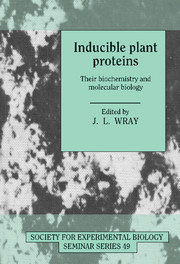Book contents
- Frontmatter
- Contents
- List of Contributors
- Preface
- Metal-binding proteins and metal-regulated gene expression in higher plants
- Phosphate starvation inducible enzymes and proteins in higher plants
- Nitrate reduction in higher plants: molecular approaches to function and regulation
- Inducibility of the glutamine synthetase gene family in Phaseolus vulgaris L.
- Expression and manipulation of genes involved in phenylpropanoid biosynthesis
- Biochemistry and molecular biology of CAM
- ABA- and GA-responsive gene expression
- Regulation of gene expression, ethylene synthesis and ripening in transgenic tomatoes
- Induction of nodulin genes and root nodule symbiosis
- Systemic acquired resistance: an inducible defence mechanism in plants
- Biochemistry and molecular biology of the anaerobic response
- The heat shock response in transgenic plants: the use of chimaeric heat shock genes
- Biochemistry and molecular biology of cold-inducible enzymes and proteins in higher plants
- GBF-1, GBF-2 and GBF-3: three Arabidopsis b-Zip proteins that interact with the light-regulated rbcS-1A promoter
- Index
Biochemistry and molecular biology of the anaerobic response
Published online by Cambridge University Press: 06 July 2010
- Frontmatter
- Contents
- List of Contributors
- Preface
- Metal-binding proteins and metal-regulated gene expression in higher plants
- Phosphate starvation inducible enzymes and proteins in higher plants
- Nitrate reduction in higher plants: molecular approaches to function and regulation
- Inducibility of the glutamine synthetase gene family in Phaseolus vulgaris L.
- Expression and manipulation of genes involved in phenylpropanoid biosynthesis
- Biochemistry and molecular biology of CAM
- ABA- and GA-responsive gene expression
- Regulation of gene expression, ethylene synthesis and ripening in transgenic tomatoes
- Induction of nodulin genes and root nodule symbiosis
- Systemic acquired resistance: an inducible defence mechanism in plants
- Biochemistry and molecular biology of the anaerobic response
- The heat shock response in transgenic plants: the use of chimaeric heat shock genes
- Biochemistry and molecular biology of cold-inducible enzymes and proteins in higher plants
- GBF-1, GBF-2 and GBF-3: three Arabidopsis b-Zip proteins that interact with the light-regulated rbcS-1A promoter
- Index
Summary
The anaerobic response
When plants experience anoxic conditions there is a shift in carbohydrate metabolism from an oxidative to a fermentative pathway (Fig. 1). In the absence of oxygen, ATP is generated not by the Krebs cycle but by alcoholic fermentation, i.e. glycolysis and ethanol synthesis.
As well as the change in carbohydrate metabolism there is a change in the pattern of polypeptide synthesis under anoxia (Sachs et al., 1980; Bailey-Serres et al., 1988). Synthesis of polypeptides normally present under aerobic conditions stops and synthesis of a number of specific polypeptides – the anaerobic polypeptides (ANPs) – commences. In maize there are about 20 ANPs which have been identified chiefly as enzymes associated with the flow of carbon into and through glycolysis and through alcoholic fermentation; in particular UDP-sucrose synthetase, pyruvate decarboxylase and alcohol dehydrogenase (ADH) are induced approximately 10-fold (Lazlo & St Lawrence, 1983; Springer et al., 1986). Glucose phosphate isomerase (Kelley & Freeling, 1984a), one of the isozymes of glyceraldehyde 3-phosphate dehydrogenase, and cytoplasmic aldolase (Kelley & Freeling, 1984b) have also been shown to be induced to a lesser degree. The levels of two enzymes which are thought to be responsible for regulating the glycolytic pathway, phosphofructokinase and pyruvate kinase, do not change significantly during anaerobiosis (Bailey-Serres et al., 1988).
It is assumed that the enzymes of glycolysis are induced by anaerobiosis to allow a greater flux of carbohydrate through the pathway because only 2 molecules of ATP are produced per molecule of glucose under anaerobic conditions whereas 36 molecules of ATP are produced under oxidative conditions.
- Type
- Chapter
- Information
- Inducible Plant ProteinsTheir Biochemistry and Molecular Biology, pp. 231 - 246Publisher: Cambridge University PressPrint publication year: 1992
- 2
- Cited by



